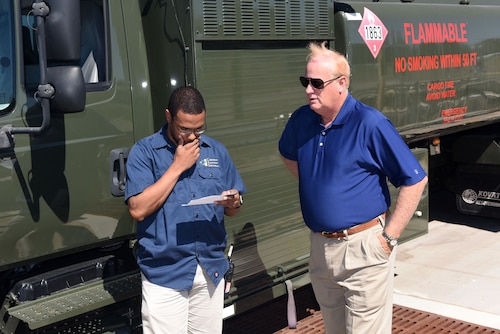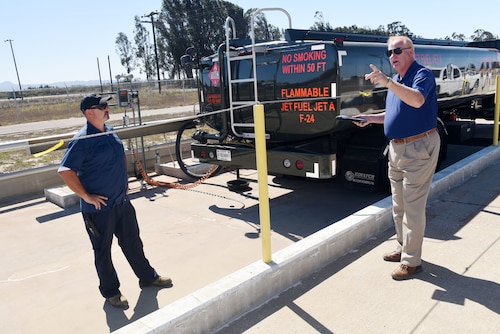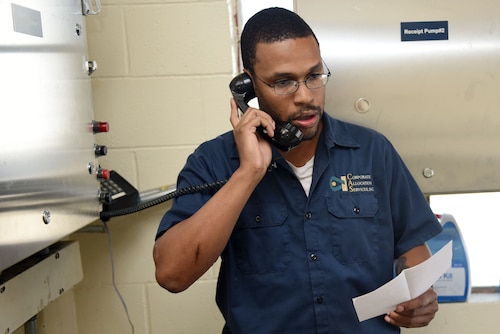VANDENBERG AIR FORCE BASE, Calif. --

DLA fuel spill exercise tests Vandenberg’s readiness
Nelson English, Defense Logistics Agency Energy instructor, trains Jerry Woiton, 30th Logistics Readiness Squadron contractor during a fuel spill exercise, Oct. 6, 2017, at Vandenberg Air Force Base, Calif. DLA Energy provides military installations with the training necessary to prevent and react to disasters, such as this simulated fuel spill, while adhering to federal regulations. (U.S. Air Force photo by Tech. Sgt. Jim Araos/Released)
1 of 3

DLA fuel spill exercise tests Vandenberg’s readiness
Tracy Taylor, Defense Logistics Agency Energy instructor, trains Jerry Woiton, 30th Logistics Readiness Squadron contractor during a fuel spill exercise, Oct. 6, 2017, at Vandenberg Air Force Base, Calif. DLA Energy provides military installations with the training necessary to prevent and react to disasters, such as this simulated fuel spill, while adhering to federal regulations. (U.S. Air Force photo by Tech. Sgt. Jim Araos/Released)
2 of 3

DLA fuel spill exercise tests Vandenberg’s readiness
Nelson English, 30th Logistics Readiness Squadron contractor, calls first responders during a fuel spill exercise, Oct. 6, 2017, at Vandenberg Air Force Base, Calif. DLA Energy provides military installations with the training necessary to prevent and react to disasters, such as this simulated fuel spill, while adhering to federal regulations. (U.S. Air Force photo by Tech. Sgt. Jim Araos/Released)
3 of 3
Members of the 30th Mission Support Group participated in its first Defense Logistics Agency Energy fuel spill exercise, here, Oct. 6.
The exercise started with a tabletop discussion between representatives from the 30th MSG and the 30th Space Wing inspector general’s office. They focused on proper procedures in response to a potential fuel spill on base. The field portion of the exercise took place at the fuels facility where a fuel truck spilled 500 gallons of fuel.
Tracy Taylor, DLA Energy instructor, provided the 30th Security Forces Squadron's S3 operations; 30th Civil Engineering Squadron’s environmental flight, readiness flight and fire department; and 30th Logistics Readiness Squadron’s material management flight leadership with the necessary training to prevent and react to disasters.
“It was our first year coming here to look at the fuels program as a whole,” said Taylor. “We had a 500 gallon spill within containment from a fuel truck, and had a realistic hose blow out. The contractors who went through the scenario performed very well.”
At the end of the exercise, Maj. Stephen Jeffers, 30th Logistics Readiness Squadron director of operations, handed out 18 certificates to each participant of the exercise.
“We did a really small spill this year, and we’ll do a larger spill next year,” said Taylor. “In the next two or three years, we can do an earthquake and drop the largest tank. The team will have to deal with a major spill incident.”
The goal for next year’s exercise will be to get a larger group of representative across the installation to participate.
“Hopefully, this type of exercise will continue to evolve here,” said Jeffers.
Throughout both portions of the exercise, all participants were able to learn something new from the scenario and can apply lessons learned in the event of a real-world disaster.
“Anytime we have multiple agencies gathered together like this for enlightening discussions, especially emergency response functions that are truly vital to our daily operations, there is always tremendous value added,” said Jeffers. “These types of training and exercise events really get to the core of what our Air Force is all about. In response to any real-world emergency situation, we will always come together as one big team and take care of each other.”